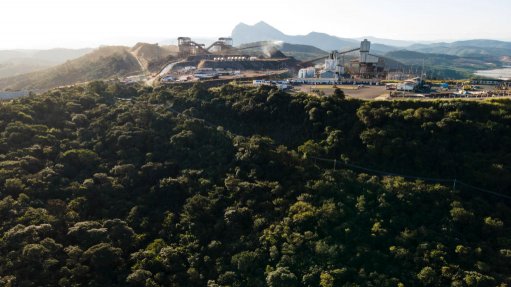Oil price crunch to change industry's growth outlook
TORONTO (miningweekly.com) – Canada’s oil sands industry is expected to continue to expand through to 2020 despite the headwinds caused by low oil prices and low natural gas prices.
However, the growth was expected to stem from project expansion rather than from any new projects getting off the ground, according to analysis from NYSE-listed IHS, released this week.
IHS Energy director Kevin Birn noted on Monday that new oil sands construction projects would be needed beyond 2018 to keep the industry growing, as all projects now under construction would be finished by then and construction would cease.
He pointed out that costs had fallen in the oil sands industry, as lower activity had allowed producers to access more efficient workers and equipment; companies had scoured their oil sands facilities for savings; operators had managed to boost utilisation rates, thereby getting more oil from existing facilities; and natural gas had become even cheaper since oil prices collapsed.
IHS's Oil Sands Dialogue published a report late last year entitled ‘Oil sands cost and competitiveness’, which estimated the scale of cost reductions in the industry. In it, IHS estimated that the cost to construct and operate a new oil sands facility had fallen by about $10/bl since 2014. By the end of 2015, IHS estimated that the lowest-cost oil sands project – an expansion of an in situ operation – could break even around $50/bl of West Texas Intermediate.
Since January, oil prices had appreciated nearly 50%, driven upwards as output fell and supply outages took place. As of June, prices had started to flirt with $50/bl. However, Birn noted that the pace of future recovery was likely to be more moderate than the preceding six months.
“An abundance of oil in storage, the prospect that US tight oil activity will respond to higher prices and the possibility that key Opec members will opt to maximise production instead of manage supply will all weigh on the pace of price recovery,” he advised.
FOCUS ON EXPANSIONS
Birn stated that, for oil sands producers specifically, the timing of future pipeline takeaway capacity remained a key uncertainty for prices in Western Canada. Further pipeline delays might slow the pace of price recovery in the Alberta oil patch, affecting timing of future investments and subsequent growth expectations.
According to Birn, these factors would both support and moderate the pace of future growth in the oil sands market. Cash-strapped US oil producers had been high-grading, or were concentrating their activity on the most productive areas, and Birn expected a similar response in the Canadian oil sands.
However, this high grading was likely to occur over multiple years as opposed to months for tight oil producers, he pointed out, noting that IHS expected oil sands investors to focus their investments on the most economic projects: expansions of existing facilities.
IHS expected that more than 80% of future activity in its outlook would be underpinned by expansions of existing facilities – these being well understood, quicker to first oil and cheaper to construct. “This all equates to less risk at a lower cost,” he said.
STRONG OUTPUT
A lack of production declines in the oil sands industry would also help support growth, IHS advised. Outside of oil sands, oil output from existing fields was expected to decline over time.
“Just to hold production flat requires a continual deployment of investment dollars in new production. In oil sands, the absence of production declines means that each investment in new oil production results in growth,” Birn explained.
In the immediate term, the impact of the May wildfires in northern Alberta would weigh on oil sands output additions in 2016, but in the long term to 2025, IHS forecast incremental growth of nearly one-million barrels a day.
“If oil sands were like most oil production sources globally and production declined over time, assuming an average global decline rate, these production additions would have to offset potential production losses in the range of half-a-million barrels. But oil sands are unique and the lack of production declines is a major factor that supports growth,” Birn stated.
He pointed out that, owing to the long lead times associated with oil sands development, growth had continued through the worst of the low oil prices. Further, a lack of output reductions in oil sands pointed to growth, owing to investments having a more direct impact on supply growth than other forms of oil production.
However, the growth would be different, characterised by lower capital costs and at a slower rate than in the past, as the pace of price recovery and future pipeline capacity came into play. “The impact of lower prices will play out over the first half of the next decade as a long aftershock of reduced investment will slow supply additions through this period,” he said.
Comments
Press Office
Announcements
What's On
Subscribe to improve your user experience...
Option 1 (equivalent of R125 a month):
Receive a weekly copy of Creamer Media's Engineering News & Mining Weekly magazine
(print copy for those in South Africa and e-magazine for those outside of South Africa)
Receive daily email newsletters
Access to full search results
Access archive of magazine back copies
Access to Projects in Progress
Access to ONE Research Report of your choice in PDF format
Option 2 (equivalent of R375 a month):
All benefits from Option 1
PLUS
Access to Creamer Media's Research Channel Africa for ALL Research Reports, in PDF format, on various industrial and mining sectors
including Electricity; Water; Energy Transition; Hydrogen; Roads, Rail and Ports; Coal; Gold; Platinum; Battery Metals; etc.
Already a subscriber?
Forgotten your password?
Receive weekly copy of Creamer Media's Engineering News & Mining Weekly magazine (print copy for those in South Africa and e-magazine for those outside of South Africa)
➕
Recieve daily email newsletters
➕
Access to full search results
➕
Access archive of magazine back copies
➕
Access to Projects in Progress
➕
Access to ONE Research Report of your choice in PDF format
RESEARCH CHANNEL AFRICA
R4500 (equivalent of R375 a month)
SUBSCRIBEAll benefits from Option 1
➕
Access to Creamer Media's Research Channel Africa for ALL Research Reports on various industrial and mining sectors, in PDF format, including on:
Electricity
➕
Water
➕
Energy Transition
➕
Hydrogen
➕
Roads, Rail and Ports
➕
Coal
➕
Gold
➕
Platinum
➕
Battery Metals
➕
etc.
Receive all benefits from Option 1 or Option 2 delivered to numerous people at your company
➕
Multiple User names and Passwords for simultaneous log-ins
➕
Intranet integration access to all in your organisation


















